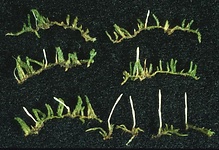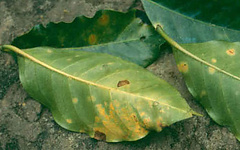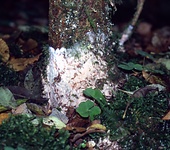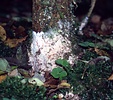Urediniomycetes
A diverse group of fungi, including rusts, yeasts, smut-like and jelly-like fungi
Elizabeth M. Frieders, David J. McLaughlin, and Les J. Szabo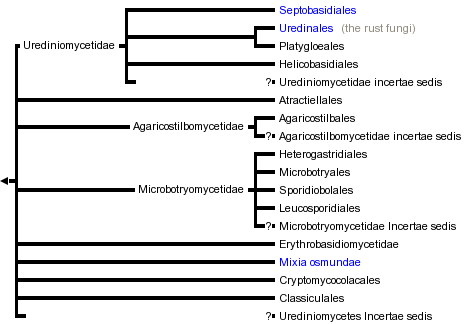


This tree diagram shows the relationships between several groups of organisms.
The root of the current tree connects the organisms featured in this tree to their containing group and the rest of the Tree of Life. The basal branching point in the tree represents the ancestor of the other groups in the tree. This ancestor diversified over time into several descendent subgroups, which are represented as internal nodes and terminal taxa to the right.

You can click on the root to travel down the Tree of Life all the way to the root of all Life, and you can click on the names of descendent subgroups to travel up the Tree of Life all the way to individual species.
For more information on ToL tree formatting, please see Interpreting the Tree or Classification. To learn more about phylogenetic trees, please visit our Phylogenetic Biology pages.
close boxIntroduction
Members of the class Urediniomycetes are remarkably diverse, possessing a wide range of structural and ecological characters. One characteristic many of these fungi have in common, however, is their rather miniscule size, making them challenging to locate and study. The apparent lack of unifying structural features of many members of the Urediniomycetes has presented a challenge to understanding their phylogenetic affiliations, and the relationships of many of these disparate taxa have been illuminated since 1995 through the acquisition of molecular sequence, biochemical and subcellular data.
The class contains approximately 7,400 species, distributed among approximately 215 genera, but will eventually be much larger as many cryptic species are recognized. More than 95% of the species and 75% of the genera in this class are placed in the Uredinales, the plant parasitic rust fungi. The next largest orders, Septobasidiales and Microbotryales, collectively constitute approximately 5% of the species and 4% of the genera. Nearly 20% of the rust genera and 60% of the nonrust genera are monotypic (containing only one species). The rust fungi and several of the yeasts have been more extensively studied than have other taxa, and the surprisingly large percentage of monotypic genera may be artificially high due to the limited research on these often obscure fungi.
The rusts are undeniably the most economically important fungi in this clade, as obligate parasites on a wide range of crop plants including cereal grains, legumes, and trees such as coffee, apple, and pine, where they can cause extensive reduction in yield and even host death. Other phytopathogenic Urediniomycetes can be of economic importance, but on a much smaller scale than rust fungi. Species of Helicobasidium cause root rot diseases of many economically important plants such as asparagus, beet, mulberry, and pear. Microbotryum violaceum causes anther smut of plants in the Caryophyllaceae, while smut on buckwheat is caused by Sphacelotheca fagopyri. These smuts are not closely related to the smuts in the Ustilaginomycetes with which they were confused until molecular sequence data became available.
For a more thorough overview of the class Urediniomycetes, see Swann et al. (2001); see Fell et al. (2001) for additional details of urediniomycetous yeasts.
Information on the Internet
- The Classification of Dimorphic Basidiomycetes A brief overview of dimorphic taxa of basidiomycetes
- Profiles of Fungi: Rust Fungi A nice overview of rust fungi
- Fungal/Insect Symbiosis and Commensalism, part 3. The Felt Fungi A description and images of Septobasidium and its scale insect host
- The Fungus Tuberculina Leads a Double Life The interesting life history of Helicobasidium (the phytoparasitic stage) and Tuberculina (the mycoparasitics stage)
- History of Microbotryum A short description of the historical importance of Microbotryum violaceum
Title Illustrations
| Scientific Name | Eocronartium muscicola |
|---|---|
| Specimen Condition | Live Specimen |
| Identified By | D.J. McLaughlin |
| Life Cycle Stage | fruitbodies on moss host |
| Collection | MIN 864444 |
| Collector | David J. McLaughlin |
| Copyright | © 2001 Bell Museum of Natural History |
| Scientific Name | Hemileia vastatrix, Coffee Rust |
|---|---|
| Location | Las Cruces, Costa Rica |
| Specimen Condition | Live Specimen |
| Identified By | D. J. McLaughlin |
| Behavior | on leaves of Coffea |
| Life Cycle Stage | uredinial stage |
| Collection | MIN862012 |
| Copyright | © 1995 Elizabeth M. Frieders |
About This Page
Elizabeth M. Frieders
Department of Biology
University of Wisconsin-Platteville
Platteville, WI 53818-3099
USA
David J. McLaughlin
Department of Plant Biology
University of Minnesota
220 Biological Science Center
1445 Gortner Ave.
St. Paul, MN 55108
USA
Les J. Szabo
USDA-ARS Cereal Disease Laboratory
1551 Lindig Street
University of Minnesota
St. Paul, MN 55108
USA
Correspondence regarding this page should be directed to Elizabeth M. Frieders at
Page copyright © 2005 Elizabeth M. Frieders, David J. McLaughlin, and Les J. Szabo
Citing this page:
Frieders, Elizabeth M., McLaughlin, David J., and Szabo, Les J. 2005. Urediniomycetes. A diverse group of fungi, including rusts, yeasts, smut-like and jelly-like fungi. Version 01 January 2005 (under construction). http://tolweb.org/Urediniomycetes/20528/2005.01.01 in The Tree of Life Web Project, http://tolweb.org/





